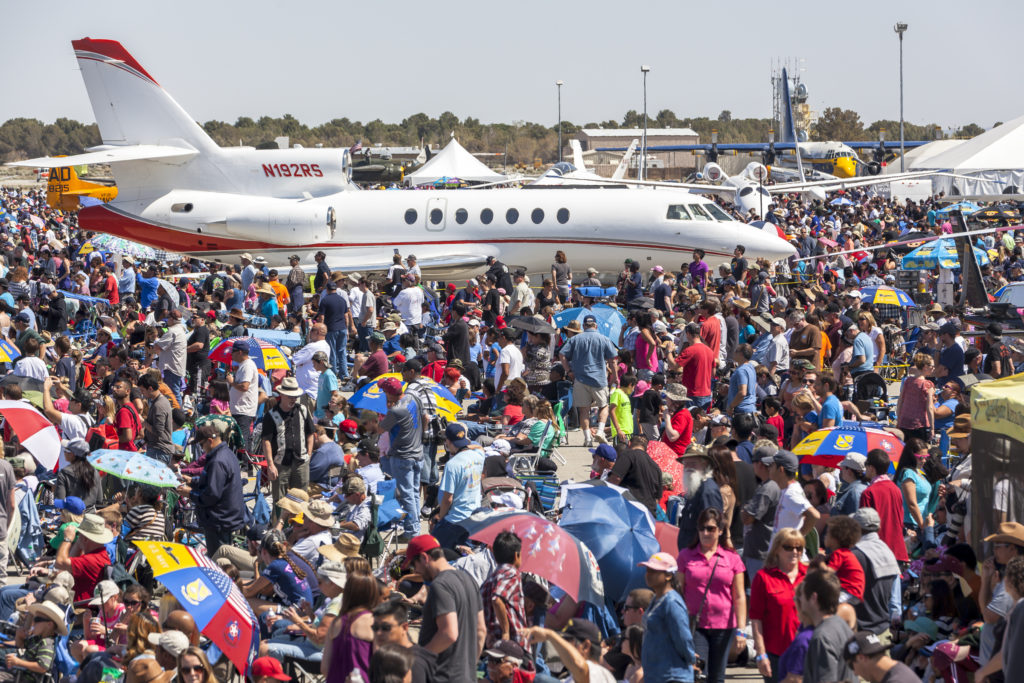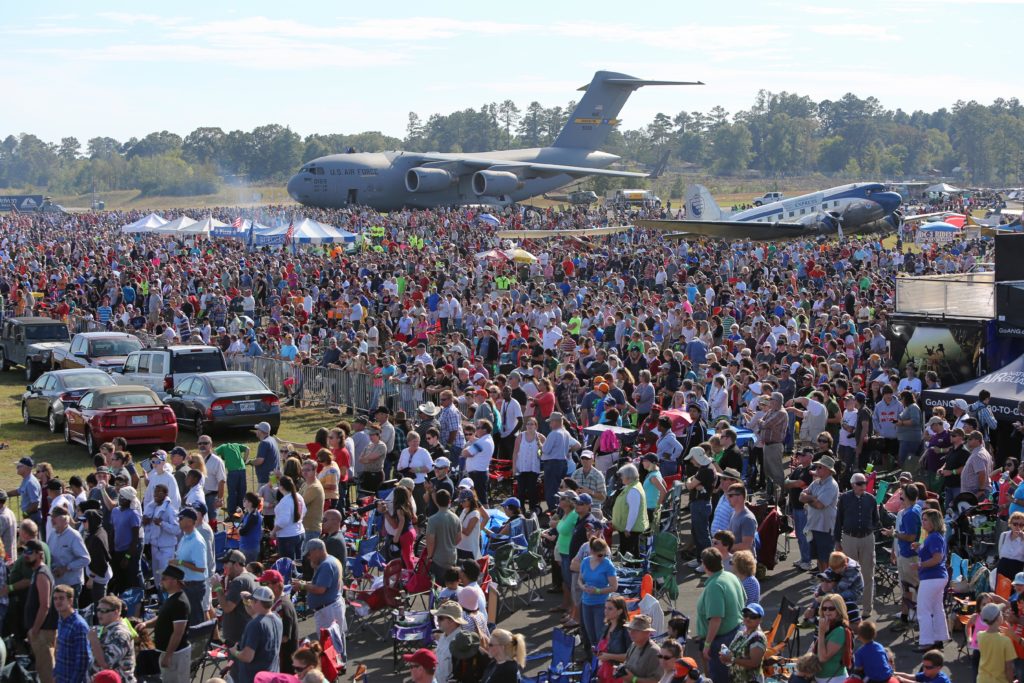Air shows are notorious for exaggerating attendance. And the only ones worse than air shows are just about every other community event in the country.
So says Steve Schmader, who heads the International Festivals and Events Association (IFEA). He also organized the River Festival in Boise, Idaho, until its demise in 2003, and has been an occasional speaker at the annual ICAS Convention. Currently, IFEA provides a wide range of services to members across North America and Schmader has been heavily involved in helping events get a grip on their attendance figures.
“Many events, by their nature, make it difficult to get an accurate head count. Crowds move around, people come in and people go out. We can count cars and multiply by three. We can count tickets sold and count the clicks on a turnstile, but, even then, it is just an estimate because there are so many variables,” said Schmader.
Accurate crowd estimates are important for several reasons, including economic impact projections and sponsorship sales.

“I worked with the first Humanitarian Bowl football game several years ago. We knew how many tickets were out there, but we had no idea if all of them were used,” Schmader said. “And there was no way to count everyone on the property outside the stadium who would be watching.”
According to Schmader, too often nobody questions attendance reports. Then, the following year someone says, “it feels as if more people were there than at the previous year’s event,” creating an even larger number since nobody wants to say attendance is down.
“When this happens, events set a trap for themselves because they think they have to keep growing to retain sponsorship support, and pretty soon, the attendance estimates become unrealistic and unsustainable,” Schmader said.
And what about parades? Schmader said Arizona State University did a study and found that you can pack about 2,500 people per mile if standing single file. Then multiply by the depth. The research shot down a Phoenix estimate of 80,000 attending a parade and revealed an attendance figure closer to 13,000.

He also cited a study that was done for an event in a gambling city, which showed the economic impact to be less than expected. When pushed to exaggerate the numbers, Schmader refused. False numbers were then presented to the city council and were challenged by the news media, which wanted proof. The organizer of the event was later fired for presenting bogus data.
“I feel that if an event is successful, you shouldn’t have to lie about your attendance or your impact. We need to be honest. It won’t change the success of the event,” he said.
According to Schmader, it’s a credibility issue.
“If we keep exaggerating, we will shoot ourselves in the foot and sponsors won’t trust us. If we can’t prove our numbers, we will lose our credibility,” Schmader said. And, he said there’s another problem associated with exaggerating figures. “The larger the crowds, the more insurance companies will charge for coverage and the more we will have to pay for fire and police protection when expanded coverage isn’t needed.”

Schmader said sponsors will know eventually if your numbers aren’t honest.
“If you tell a sponsor you have a million people over the course of a weekend and they only give out five thousand samples, they will realize something is wrong and may not return the following year,” Schmader said.
Inaccurate attendance reporting came back to bite the Oregon International Air Show in recent years. With improved technology, they have been able to get a much better handle on their attendance and the figures have turned out to be less than previously thought.
“When we reported this to our title sponsor, their financial support was lowered. The same for other key sponsors. But now, they trust our data and we have a path forward with them to regain lost revenue,” said Oregon International Air Show President Bill Braack.

The show has yet to max out its available spectator space, but it has come close at times.
“Our police and fire departments tell me the largest general admission crowd we can accommodate is 27,000 on our ramp. When you add in our volunteers, first responders, upgraded seating and sponsor areas and then multiply by three days, we can handle no more than 110,000 people. We know that and so do our sponsors, so we have to be honest with them,” he said.
However, no matter how good the technology is, there will still be some guesstimating that all events have to do.
“We can account for every ticket sold online and through the gate. And we can account for our volunteers, firefighters, and police to get to a total audience number on the field. What we can’t account for is the number of people watching the show outside the fence,” says Braack.

At the Vectren Dayton Air Show in Ohio, Executive Director Terry Grevious says they have enough experience to know what to expect within a range.
“Normally, we have between 50,000 and 65,000 spectators depending on which jet team we host. And if the weather is bad, we will go as low as 30,000,” Grevious said.
While inflating attendance is tempting, especially when competing for military jet teams, Grevious said it is important to be honest about attendance and that sponsors aren’t concerned about growth. They are more concerned about quality. “There is no accountability for inflated figures unless you are challenged and — if you can’t verify your data — you lose credibility with your sponsors. They feel misled and may end their participation,” he said.
The DD Form 2535 submitted to the U.S. Department of Defense to request military participation requires attendance data, but those numbers are not a significant factor when teams decide where they are going to perform.
Jennifer Bentley is Chief of Community
Outreach and Policy in the Secretary of Air Force Public
Affairs office where they make those decisions.
“We prepare a list of recommended show sites based on a variety of factors. We look at our recruiting needs, look at where we have been recently, look at where requests come in that we haven’t visited for a time, and then we look at projected attendance,” Bentley said.
Some military bases hold annual events. Others are less frequent, so attendance numbers can vary from one show to another, making them less of a factor.

“We don’t question attendance numbers if a show is in an area that makes sense to us. Air Force priorities are always considered first. If one base hasn’t had a show in ten years or if another is celebrating an anniversary or something similar, we will add them to the list which is then submitted to the Thunderbirds who make the final selection,” she said.
While attendance statistics don’t really matter when the jet teams make their selections, Bentley said she would like to see accuracy improve.
“I want to be able to say we reached out to this many people and know the number is as accurate as possible. We don’t always go to the biggest shows, but we do look for recruiting impact no matter the size of the show or the size of the community,” she said. And if there is any doubt about the attendance, she said they will do additional research before making a decision.
Keeping track of numbers gets to be a challenge for the Cleveland National Air Show, according to Executive Director Kim Dell. Attendance ranges from 60,000 to 100,000 over a weekend, depending on weather and acts, but — because Cleveland sits along Lake Erie — there are thousands of fans in boats on the water who watch, too. The show is held over Labor Day weekend which is the last big outing of the summer for many people.
“We want to be honest with our sponsors. We try to be conservative with our crowd estimates so we won’t get a lot of pushback. When talking to a new sponsor, we explain up front all the variables that will impact attendance,” Dell said.
She said they closely track advance ticket sales, gate sales, corporate tickets and sponsor tickets, then add in the volunteer credentials they issue.
“We keep detailed records and have a good system for accounting. We also use an independent firm to audit us after every event and they are the ones who count the tickets, not us,” she said.
Dell says exaggerating attendance will eventually catch up to you.
“If you tell an ice cream vendor to prepare for 200,000 people and he only sells a quarter of his inventory, it will cost him a lot of money and puts your credibility in doubt,” she said.
Where the landing gear really meets the tarmac when it comes to attendance numbers is with vendors; air show veterans recognize that if you want to know how many people came to an air show, just ask the concessionaires. They have a better grasp of the situation than almost anyone else.
Some concessionaires do a wide variety of events. But President/CEO Jim Breen of The Air Show Network does only air shows, and knows better than to believe some of the attendance figures he hears. He does his own homework.
“I understand that some show organizers feel they are at a disadvantage if they don’t inflate their numbers, because some sponsors make their decisions, in part, on how many people they can reach. But for a small city to claim an attendance of 210,000 is ridiculous,” Breen said.

Breen even questions some shows that claim weekend attendance of a million or more.
“To handle that many people is almost physically impossible. It would require 1,700 acres of parking and a significant fleet of buses to move people and I just haven’t seen it,” Breen said. He notes that an audience of 500,000 people should result in food sales of more than $4 million. “That just doesn’t happen,” he said.
Breen notes that, 25 years ago, our industry claimed that air shows had the second-largest number of spectators in the country — second only to major league baseball.
“That was a false claim then and it’s false now because there is no way to verify it,” he said. Breen said exaggerated attendance numbers make the entire industry look silly and unsophisticated.
In the 1980s, there was a story circulating about an air show organizer who was charged with embezzlement by an overzealous prosecuting attorney because the revenue the show reported did not match the attendance count. That story has never been verified. However, with today’s technology tracking attendance, it has become easier than ever before to obtain accurate attendance numbers — and the air show industry is the better for it.








